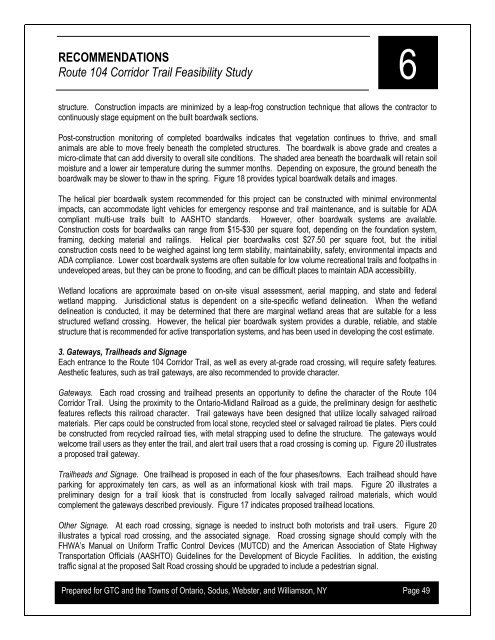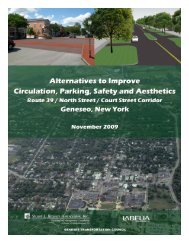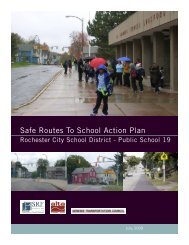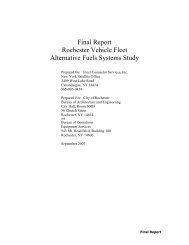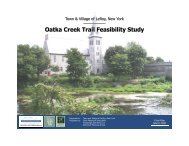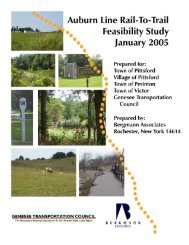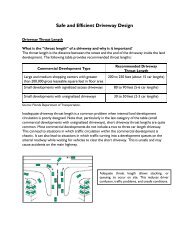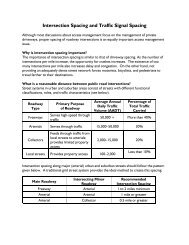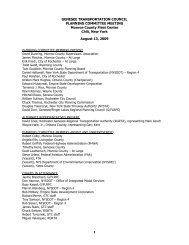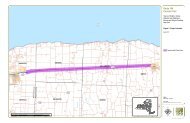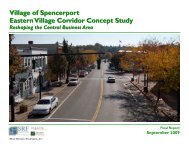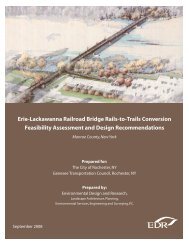Route 104 Corridor Trail Feasibility Study - Genesee Transportation ...
Route 104 Corridor Trail Feasibility Study - Genesee Transportation ...
Route 104 Corridor Trail Feasibility Study - Genesee Transportation ...
Create successful ePaper yourself
Turn your PDF publications into a flip-book with our unique Google optimized e-Paper software.
RECOMMENDATIONS<br />
6<br />
<strong>Route</strong> <strong>104</strong> <strong>Corridor</strong> <strong>Trail</strong> <strong>Feasibility</strong> <strong>Study</strong><br />
structure. Construction impacts are minimized by a leap-frog construction technique that allows the contractor to<br />
continuously stage equipment on the built boardwalk sections.<br />
Post-construction monitoring of completed boardwalks indicates that vegetation continues to thrive, and small<br />
animals are able to move freely beneath the completed structures. The boardwalk is above grade and creates a<br />
micro-climate that can add diversity to overall site conditions. The shaded area beneath the boardwalk will retain soil<br />
moisture and a lower air temperature during the summer months. Depending on exposure, the ground beneath the<br />
boardwalk may be slower to thaw in the spring. Figure 18 provides typical boardwalk details and images.<br />
The helical pier boardwalk system recommended for this project can be constructed with minimal environmental<br />
impacts, can accommodate light vehicles for emergency response and trail maintenance, and is suitable for ADA<br />
compliant multi-use trails built to AASHTO standards. However, other boardwalk systems are available.<br />
Construction costs for boardwalks can range from $15-$30 per square foot, depending on the foundation system,<br />
framing, decking material and railings. Helical pier boardwalks cost $27.50 per square foot, but the initial<br />
construction costs need to be weighed against long term stability, maintainability, safety, environmental impacts and<br />
ADA compliance. Lower cost boardwalk systems are often suitable for low volume recreational trails and footpaths in<br />
undeveloped areas, but they can be prone to flooding, and can be difficult places to maintain ADA accessibility.<br />
Wetland locations are approximate based on on-site visual assessment, aerial mapping, and state and federal<br />
wetland mapping. Jurisdictional status is dependent on a site-specific wetland delineation. When the wetland<br />
delineation is conducted, it may be determined that there are marginal wetland areas that are suitable for a less<br />
structured wetland crossing. However, the helical pier boardwalk system provides a durable, reliable, and stable<br />
structure that is recommended for active transportation systems, and has been used in developing the cost estimate.<br />
3. Gateways, <strong>Trail</strong>heads and Signage<br />
Each entrance to the <strong>Route</strong> <strong>104</strong> <strong>Corridor</strong> <strong>Trail</strong>, as well as every at-grade road crossing, will require safety features.<br />
Aesthetic features, such as trail gateways, are also recommended to provide character.<br />
Gateways. Each road crossing and trailhead presents an opportunity to define the character of the <strong>Route</strong> <strong>104</strong><br />
<strong>Corridor</strong> <strong>Trail</strong>. Using the proximity to the Ontario-Midland Railroad as a guide, the preliminary design for aesthetic<br />
features reflects this railroad character. <strong>Trail</strong> gateways have been designed that utilize locally salvaged railroad<br />
materials. Pier caps could be constructed from local stone, recycled steel or salvaged railroad tie plates. Piers could<br />
be constructed from recycled railroad ties, with metal strapping used to define the structure. The gateways would<br />
welcome trail users as they enter the trail, and alert trail users that a road crossing is coming up. Figure 20 illustrates<br />
a proposed trail gateway.<br />
<strong>Trail</strong>heads and Signage. One trailhead is proposed in each of the four phases/towns. Each trailhead should have<br />
parking for approximately ten cars, as well as an informational kiosk with trail maps. Figure 20 illustrates a<br />
preliminary design for a trail kiosk that is constructed from locally salvaged railroad materials, which would<br />
complement the gateways described previously. Figure 17 indicates proposed trailhead locations.<br />
Other Signage. At each road crossing, signage is needed to instruct both motorists and trail users. Figure 20<br />
illustrates a typical road crossing, and the associated signage. Road crossing signage should comply with the<br />
FHWA‘s Manual on Uniform Traffic Control Devices (MUTCD) and the American Association of State Highway<br />
<strong>Transportation</strong> Officials (AASHTO) Guidelines for the Development of Bicycle Facilities. In addition, the existing<br />
traffic signal at the proposed Salt Road crossing should be upgraded to include a pedestrian signal.<br />
Prepared for GTC and the Towns of Ontario, Sodus, Webster, and Williamson, NY Page 49


